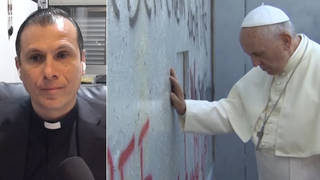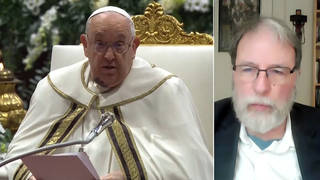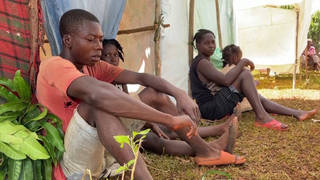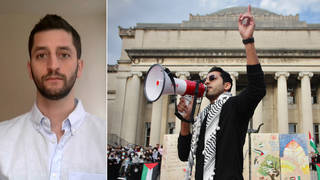
Guests
- Reed LindsayWashington, DC bureau chief of Telesur, the Latin American satellite TV network. He’s been in Haiti since January 13th, a day after the earthquake struck. Reed Lindsay was formerly the Haiti correspondent for Telesur from 2004 to 2009.
One month after the earthquake in Haiti, the official death toll is now at 230,000. On Tuesday, Haitian Prime Minister Jean-Max Bellerive said it would take another ten years to rebuild Haiti and admitted officials have no clear plan for relocating the one million Haitians made homeless by the earthquake. We go to the Haitian capital of Port-au-Prince to speak with journalist Reed Lindsay. [includes rush transcript]
Transcript
AMY GOODMAN: It’s been four weeks since the earthquake in Haiti, and the country’s authorities are continuing to revise their estimates of the number of people who have died. The latest official death toll is at 230,000.
On Tuesday, Haitian Prime Minister Jean-Max Bellerive said it would take another ten years to rebuild his shattered country and admitted that officials did not have a clear plan for how to relocate the one million Haitians made homeless by the earthquake. Meanwhile, at an emergency meeting of the Union of South American Nations in Ecuador, leaders pledged $300 million in aid to Haiti.
Well, for more on this story, we will soon be joined by actor, activist and TransAfrica Forum chair Danny Glover. He’s recently returned from South Africa, where he met with the ousted former Haitian president Jean-Bertrand Aristide. But first we’re going to the Haitian capital of Port-au-Prince, where we’re joined by journalist Reed Lindsay. He’s the Washington, DC bureau chief of Telesur, the Latin American satellite TV network. He’s been in Haiti since January 13th, a day after the earthquake struck. Reed was formerly the Haiti correspondent for Telesur from 2004 to 2009.
There’s a very big delay in the satellite from New York to Port-au-Prince, but Reed, if you can just tell us, on this day, a month later, that the estimates have been — have gone up again of the number dead, on par with the Asian tsunami — we’re talking more than [230,000] dead — tell us what you’re finding around Haiti.
REED LINDSAY: Well, Amy, I actually just returned from a trip to the countryside. In the time I’ve been here, I hadn’t had an opportunity to go yet. I’ve been in Port-au-Prince. And of that figure that you mentioned, a million people homeless, it might be far greater than that, because everywhere I went, in every community and small village, I found families that had taken in family members from Port-au-Prince who had lost their homes and had moved there.
We went to one commune that is extremely poor called Anse Rouge, about five or six hours north of Port-au-Prince, and an area where they produce — they harvest salt for a living. It’s extremely poor. The people, they have water once a week. There’s almost no agricultural production, very little food. And in one house, for example, I found a family that before was — that had nine members and now had twenty-five. Sixteen people had come from the capital to live with them. One of them, the leader of the household, who is thirty years old, her entire life she had lived in Port-au-Prince, and now she’s been a month in the countryside. Again, very little water. They have to ration their water. And these are displaced people, too, but they’re not the displaced people that you see in the camps here in Port-au-Prince that are more visible. She has no plans of returning to Port-au-Prince with her family. She is, in the near future, going to stay there, because she has nowhere to come back to. Her house that her father had constructed in Port-au-Prince was destroyed. And everywhere I went in the countryside, I saw this story repeated in every community.
The last figure that I heard was that close to 500,000 people who had fled to the countryside, but it could be much more. In fact, they were still counting people. There were community leaders counting people, in community by community, who had gone to the countryside. And the problem is, is that over the last twenty or thirty years, Haiti has been devastated by neoliberal economic policies that have basically forced peasants to immigrate — to migrate to the city and to try to look for work and to send their kids to school here, because there’s been absolutely no investment in the countryside. And now they’re going back to the countryside. There’s this reverse migration. But there’s nothing there. There’s no support. There’s no schools. And the schools that do exist, they have to pay, and they don’t have money to send their kids there.
There’s very little agricultural production, and because they have no support. And, of course, they can’t compete with imported food coming from mainly from the United States. This country is completely dependent on imported rice. And twenty, thirty years ago, Haitians only ate rice on Sundays, and it was rice that was grown in Haiti. In fact, we went to the rice-growing region, as well, in the Artibonite and spoke with rice farmers. And they said — they told us that they wish they could produce the food to feed the hungry in Port-au-Prince, but they can’t, because, again, they’ve been abandoned for all of these years. And they, themselves, have taken in these people from Port-au-Prince. They’re very concerned with the high price of fertilizer. And again and again, we’ve heard peasants tell us that they didn’t — that what they thought was most important with aid was a long-term investment to support small-scale producers, to support national production, agricultural production, and not just food aid, not just handouts.
AMY GOODMAN: We’re talking to Reed Lindsay in Washington, DC, the bureau chief of Telesur. Reed — we’re speaking to him in Port-au-Prince in Haiti. There is a long delay between my question being conveyed to him and him answering. But Reed, I wanted to ask you about Titanyen. For people who have spent time in Haiti, certainly for Haitians, they know well this area, the significance of it during the coup times, with thousands of bodies being buried in this, what is seen as a massacre site, a killing field. Talk about Titanyen today.
REED LINDSAY: Well, in fact, driving back from the countryside yesterday afternoon, you know, we passed by Titanyen, and we saw a big crowd of people gathered, and we were curious to find out what they were doing. So, right in Titanyen, in this area where they — bodies have always been dumped and where bodies continue to be dumped since the earthquake. And we drove down this dirt road toward where these people were gathered and right past what couldn’t even be described as bodies, just body parts, and just thrown in the middle of the road. And the stench was unbelievable.
And downwind from this was a food distribution organized by the government. Most food distributions you see in Port-au-Prince are organized by the international community. This one was — there were no UN present. It was organized by the government. There were Haitian police. And they were giving out food that was donated by Mexico. And lines of hundreds of people with no — breathing in this unbelievable smell of bodies nearby, but so desperate for food that they had no other option but to wait there. And of course, as usual, and in fact, in almost — it seems like almost every food distribution I’ve seen, the food ran out, and the truck, you know, closed its doors and left empty. And, you know, hundreds of people were there, left empty-handed.
After all these people left, we hung around a little and took some images there, and we saw a family actually building a shelter there, a man and his wife and his son, and they were constructing a shelter with sticks and in almost the same place, downwind from these bodies, where really it was difficult to even breathe. And the mother had — was covering her face with a towel as her husband and son constructed the shelter. And I asked them, why — you know, I just couldn’t fathom how they could be there. How could there be a worse place in the world to want to live? And they are clinging to this hope, because they had heard that there might be a big camp set up there. And apparently some government official — it’s not clear who — had told them that they could — they might be able to find housing in some sort. And as a result, they went and claimed their bit of land there. And I asked them, I said, “Why are — you’re the only ones here. Why are you here?” And they said, actually, that there were families all over the place who had claimed land they hadn’t — and you could see here and there shelters that had begun to be constructed. But it just struck me. It hit me so hard, because they just seemed totally without hope, without spirit. And to be reduced to this level where they would want to live in a place like that was, I mean, just — it really shows how desperate the situation continues to be here in Haiti.
AMY GOODMAN: We’re talking to Reed Lindsay. He is the DC bureau chief for Telesur. He’s in Port-au-Prince, has been there since a day after the earthquake. He lived in Haiti for years, certainly knows the story of Haiti. Reed, can, finally, you talk about what Haitians’ attitudes are right now toward the United States, toward the US military presence? You were there in 2004 when President Aristide was ousted, was taken out of the country by US military and security, flown off to the Central African Republic. Talk about today, the earthquake, and that — how that connects to then.
REED LINDSAY: Well, of course, Amy, actually, I wasn’t there when Aristide was taken away. I was in a few weeks previous to that. I actually had to leave shortly before, but I was there from October 2004 on.
And, you know, it’s definitely — you see the US troops everywhere. And actually, several days ago, we were — I was in a place called Pétionville Club, which is like the only golf club, golf course in Haiti. It’s not much of a golf course, but it’s a very exclusive club. There’s tennis courts. It’s a place where very wealthy Haitians and foreigners, Americans, mainly go to spend time at the bar and have drinks and play tennis, and there’s a swimming pool there. And this has been taken — the club part of it has been taken over by the US soldiers. They would have gotten permission, of course, from the owner of the club. And there’s 360 of them there, and it’s one of the first places that they established a sort of a camp there, in the early days, the Saturday after the earthquake. And down the hill on the golf course, there are an estimated 65,000 people. And, of course, they’re separated off, sort of. There’s a cord, a ribbon, separating them from the upper part where the club is. And those soldiers are there. In fact, talking to people there, they’re appreciative, because they have actually gotten some help, much more help than I’ve seen in any other camp. What’s interesting is that right in between — that this club that’s been converted into a base actually is right in between these 65,000 people and the ambassador’s residence, which is right next door.
But, I mean, one thing that is striking to me with the soldiers is they just don’t — you just have to question how much they’re really helping. It’s not that they’re not helping. I mean, they are helping in logistical ways and whatnot. But if you look at the amount of money that is being invested in having this presence of troops here and the ways in which they’re contributing, I think you have to question that. I mean, just spending a couple hours at the club in the morning, most of the troops, they’re jogging. They’re — you know, they have their presence, and it’s a security presence. But, you know, when I was down in the camp, a four-year-old child was run over by a water truck that had lost control, that apparently was water from UNICEF. It had UNICEF stickers on it. And I ran up, you know, desperate and to tell some authority to try to talk to the family, what could be done for them. And I told a bunch of soldiers, and they just sort of shrugged their shoulders, and, you know, sort of complete indifference. On other occasions on the streets, I’ve seen soldiers, and I’ve asked them, “Where are you going? What are you doing?” And, you know, often they don’t really have a clear idea.
And, you know, this is a country that had a UN peacekeeping mission before these US troops got here. There’s no — security is not an issue. It is always the number one issue for the international community, since I’ve been here. But for the Haitian people, it is not the issue. The issue is — the issue is — the immediate issue is hunger. People are hungry. They need water. They need shelter. And the long-term issue is they want to be able to not be dependent anymore. They want to be able to produce. They want to be able to have the possibility of doing that. They want to have investment in this country. And they’re not concerned about security. So, you know, you have to wonder, why are these troops here? How long will they continue to be here? And how are they really contributing?
AMY GOODMAN: The attitude, Reed Lindsay, of the European Union dealing with the United States in Haiti right now?
REED LINDSAY: Well, the attitude of the Haitians toward the European Union?
AMY GOODMAN: The attitude of European Union in how it’s dealing — in how the United States is dealing, and also the issue of Haitian migrants, Haitians that are trying to leave Haiti right now — well, both the injured but also those who are just trying to leave?
REED LINDSAY: Right. Well, Amy, I can’t — to be honest, I can’t tell you that much about the European Union. They’re sort of — I’m sort out in the streets a lot. And a lot of things — I’m oblivious to a lot of important things that are going on here, because the way that we’re working in Telesur, so that everyone has their beat, and my beat has just been going out on the street and talking to people.
You know, one thing that I can say is that Haitians are, just because of their history, you know, their long history and the relationship with — and this history of domination, exploitation, not only by the United States, but of course you begin with France, and in recent years, you know, Canada and the United Nations peacekeeping mission. I mean, I don’t — when I talk to Haitians, they don’t see necessarily a US soldier differently than they see a Canadian soldier or a UN peacekeeper. For them, they’re all foreign soldiers that are here in their country. And they wouldn’t — you know, some are very nationalistic, and they don’t like — they don’t want any — the presence of any soldiers. But mainly it’s — they’ve seen these soldiers. The UN peacekeeping mission has been here since 2004, and these soldiers have been around everywhere, and they haven’t done anything to change the country. And Haitians are very frustrated with that. And as a foreigner, even not as a soldier, just as a foreigner, you really feel it, this resentment, because, you know, these countries have been so dominant in Haiti in recent years. The United States and France and Canada have done — you know, in the eyes of Haitians, they’ve done very little to help improve the situation, and they’re very frustrated for that.
AMY GOODMAN: Well, I want to thank you very much, Reed Lindsay, for being with us. Reed is in Port-au-Prince right now. He’s been there since the day after the earthquake. He is the Washington, DC bureau chief of Telesur.













Media Options